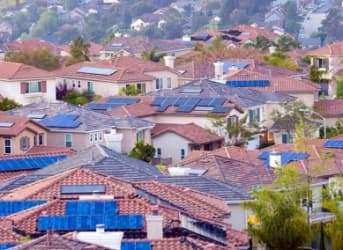The electric utility is at a crossroads. Facing flat electricity demand and a sudden insurgent campaign from rooftop solar, the large centralized utility company is entering a new era.
Largely unchanged for a century, utility companies have made their money by building power plants and transmission lines and selling electricity at a regulated price. In exchange for regulation, the utilities were guaranteed a profitable return. This was largely a boring business with little major change.
But the dramatic declines in costs for renewable energy are upending this arrangement. In particular, rooftop solar, which allows residential consumers to become electricity producers, threatens to whittle down the utility’s customer base. Related: The Cost Of Energy Storage
In 2014, the U.S. installed 6.2 gigawatts of new solar power, a 30 percent jump over the year before. While that may not seem like much, the trend is clear: solar was second only to natural gas in terms of newly added capacity in 2014. The same will continue in 2015. Greentech Media predicts another 8.1 gigawatts in 2015, an additional 59 percent jump from 2014.
Slowly but surely, utilities are losing customers. But as The Washington Post reported on March 7, utilities have not been sitting idle. After a private meeting in 2012 held by the Edison Electric Institute, the industry’s trade group, utilities decided to wage a public policy war on solar. First, they have attacked net metering charges in state legislatures, although many efforts came up short. Next they moved to more opaque public utility commissions (PUCs), successfully getting PUCs to put new fees on solar homes in Wisconsin and Arizona, with more states considering similar measures.
But the aggressive push by the utility has sparked a backlash, evidenced by a current fight playing out in Florida. The state of Florida does not allow consumers to buy solar from anyone except the utility. That monopoly stranglehold has angered a lot of people, creating an unlikely alliance between environmentalists, conservatives, and libertarians. Floridians for Solar Choice, a grassroots organization, is gathering signatures for a 2016 ballot initiative that would open up the sector for solar generators. Having a “choice” between energy suppliers is how the group is framing the issue, something that is apparently attractive to people across the political spectrum. The group is well on its way, having already obtained 100,000 out of the required 700,000 signatures to get the issue on the ballot. Florida’s Libertarian party has officially come out in support of the effort. Related: Electric Utilities Face A Disruptive Future
While the utility industry hopes to stifle its competition, its policy war may only slow the inevitable. Costs for solar power have plummeted by 80 percent in the last six years, and still have a ways to go. In fact, the International Energy Agency predicts that solar will be the cheapest form of electricity worldwide by the middle of the next decade.
The smarter utilities are moving with the tide rather than fighting it. Solar threatens to slash the utility’s customer base, but a whole new pool of potential customers for electricity sales exists with electric vehicles (EVs). To take one small example, Georgia Power, the utility that will operate the Vogtle nuclear power plant that is currently under construction, is offering its ratepayers a $250 rebate to build EV charging stations.
The New York Times profiled several utilities that are strongly supporting the rollout of EV charging stations. Pacific Gas and Electric wants to spend $654 million to build 25,000 EV chargers in California. The state has a goal to build 100,000 chargers by 2020. That compares to the 22,900 chargers currently in use in the entire country. Related: Utilities Stumbling Into A New Dawn
NRG is another utility getting in on the game. Through its subsidiary NRG eVgo, NRG is building a network of fast-charging EV stations, capable of charging a car in 30 minutes. It has a presence in California, Texas, Washington DC, Maryland, and Virginia, and hopes to expand in major cities across the U.S.
And this offers a new path forward for utilities. Some will fight a losing battle against solar power, while others will pivot to new markets (not that those two choices are mutually exclusive). Utilities can play a big role in building out EV infrastructure because they can factor it into the rate that it charges customers. PG&E’s plan for 25,000 charging stations may only cost its customer base $0.70 per month.
“Everyone talks about the utility death spiral but it is largely exaggerated,” Brett Hauser, the CEO of EV builder Greenlots, told UtilityDive. “Just like everybody else, utilities have to evolve and find better ways to communicate and interact with their customers.”
ADVERTISEMENT
By James Stafford of Oilprice.com
More Top Reads From Oilprice.com:
- Can Tesla’s Latest Venture Live Up To The Hype?
- Utilities Facing Coal Shortages Due To Rail Congestion
- Spanish Utility Cutting Off A Piece Of US Shale Gas Cake

















